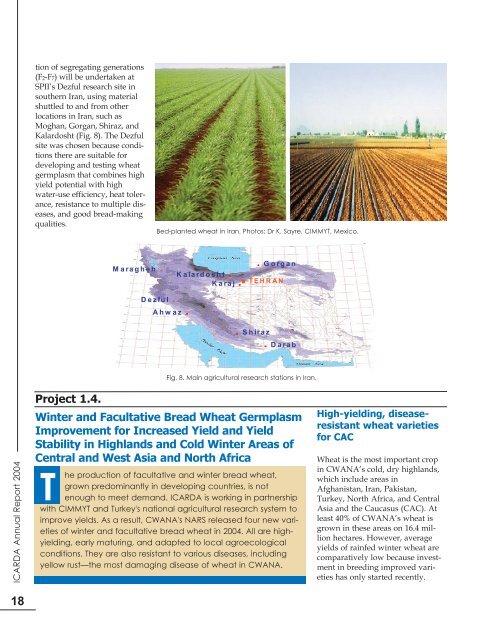ICARDA annual report 2004
ICARDA annual report 2004
ICARDA annual report 2004
You also want an ePaper? Increase the reach of your titles
YUMPU automatically turns print PDFs into web optimized ePapers that Google loves.
<strong>ICARDA</strong> Annual Report <strong>2004</strong><br />
18<br />
tion of segregating generations<br />
(F2-F7) will be undertaken at<br />
SPII’s Dezful research site in<br />
southern Iran, using material<br />
shuttled to and from other<br />
locations in Iran, such as<br />
Moghan, Gorgan, Shiraz, and<br />
Kalardosht (Fig. 8). The Dezful<br />
site was chosen because conditions<br />
there are suitable for<br />
developing and testing wheat<br />
germplasm that combines high<br />
yield potential with high<br />
water-use efficiency, heat tolerance,<br />
resistance to multiple diseases,<br />
and good bread-making<br />
qualities.<br />
Project 1.4.<br />
Maragheh .<br />
Bed-planted wheat in Iran. Photos: Dr K. Sayre, CIMMYT, Mexico.<br />
Dezful .<br />
Ahwaz .<br />
. Gorgan<br />
Kalardosht .<br />
Karaj .<br />
TEHRAN<br />
. Shiraz<br />
. Darab<br />
Fig. 8. Main agricultural research stations in Iran.<br />
Winter and Facultative Bread Wheat Germplasm<br />
Improvement for Increased Yield and Yield<br />
Stability in Highlands and Cold Winter Areas of<br />
Central and West Asia and North Africa<br />
T he<br />
production of facultative and winter bread wheat,<br />
grown predominantly in developing countries, is not<br />
enough to meet demand. <strong>ICARDA</strong> is working in partnership<br />
with CIMMYT and Turkey's national agricultural research system to<br />
improve yields. As a result, CWANA's NARS released four new varieties<br />
of winter and facultative bread wheat in <strong>2004</strong>. All are highyielding,<br />
early maturing, and adapted to local agroecological<br />
conditions. They are also resistant to various diseases, including<br />
yellow rust—the most damaging disease of wheat in CWANA.<br />
High-yielding, diseaseresistant<br />
wheat varieties<br />
for CAC<br />
Wheat is the most important crop<br />
in CWANA’s cold, dry highlands,<br />
which include areas in<br />
Afghanistan, Iran, Pakistan,<br />
Turkey, North Africa, and Central<br />
Asia and the Caucasus (CAC). At<br />
least 40% of CWANA’s wheat is<br />
grown in these areas on 16.4 million<br />
hectares. However, average<br />
yields of rainfed winter wheat are<br />
comparatively low because investment<br />
in breeding improved varieties<br />
has only started recently.



